engine AUDI A8 2014 Workshop Manual
[x] Cancel search | Manufacturer: AUDI, Model Year: 2014, Model line: A8, Model: AUDI A8 2014Pages: 314, PDF Size: 78.47 MB
Page 202 of 314
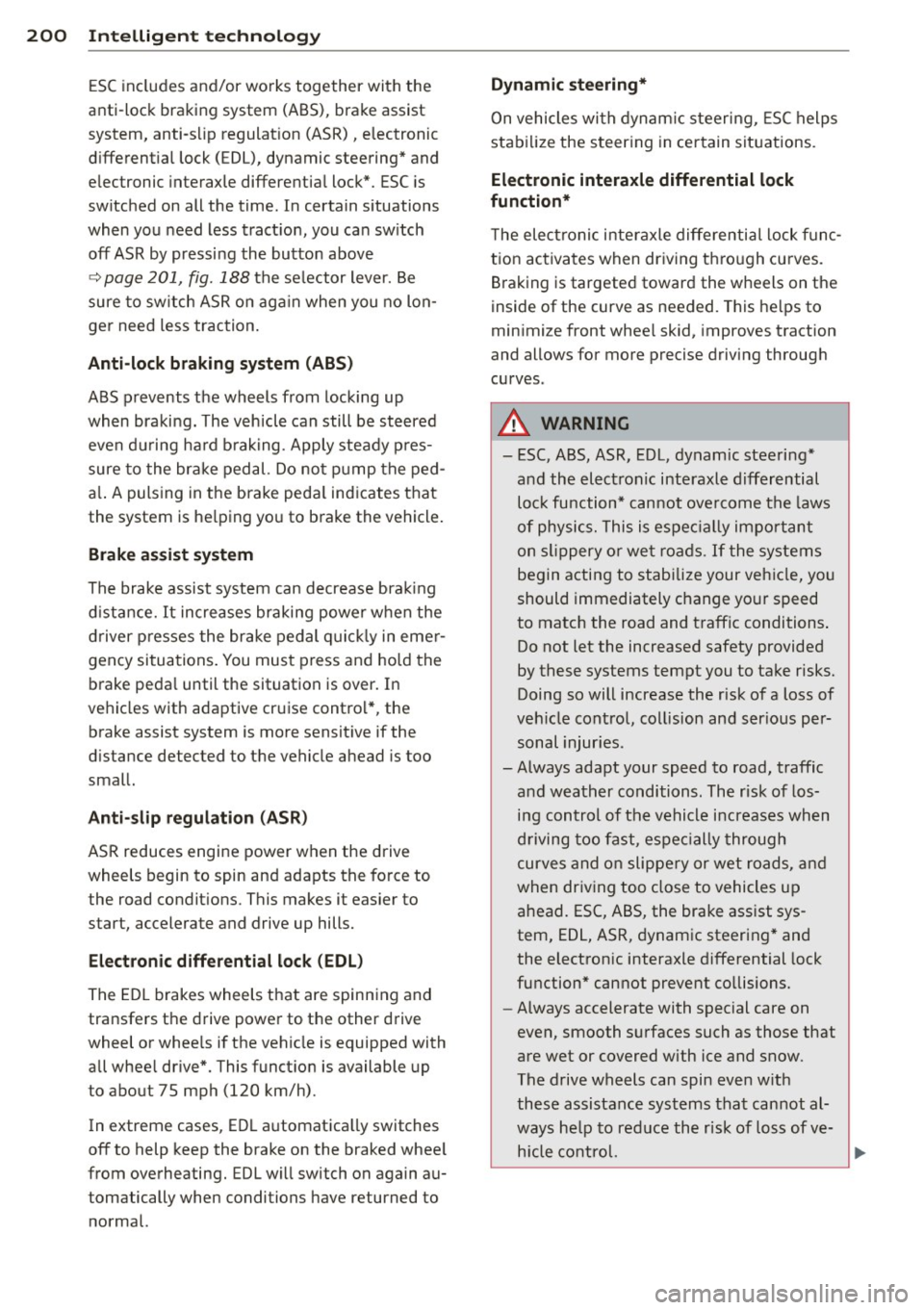
200 Intellig ent technol ogy
ESC includes and/or works together with the
anti-lock braking system (ABS), brake assist
system, anti-slip regulat ion (ASR), electronic
d ifferential lock (EDL), dynamic steering* and
electronic interaxle differential lock*. ESC is
switched on all the time. In certain situations
when you need less tract ion, you ca n sw itch
off ASR by pressing the button above
~ page 201, fig. 188 the se lector lever. Be
sure to sw itch ASR on aga in when you no lon
ger need less traction.
Anti -lock braking system (ABS )
ABS prevents the wheels from locking up
when braking. The vehicle can still be steered
even du ring ha rd b raking . Apply steady pres
sure to the brake pedal. Do not pump the ped
a l. A pulsing in the brake peda l indicates that
the system is he lping you to brake the vehicle.
Br ake assist system
The brake assist system can decrease brak ing
d istance. It increases braking power when the
d river p resses the brake pedal q uick ly in emer
gency situations. You must press and hold the brake peda l until the situation is over. In
vehicles with adaptive cruise control*, the brake assist system is more sensitive if the
d istance detected to the vehicle ahead is too
small.
Anti- slip regulati on (ASR )
ASR reduces engine power when the drive
wheels begin to spin and adapts the force to
the road condit ions. This makes it easier to
start, accelerate and drive up hills.
El ectronic diff erential lo ck (EDL )
The ED L brakes wheels that are spinning and
transfers the drive power to the other drive
wheel or whee ls if the vehicle is equipped with
all whee l drive*. This funct ion is available up
to about 7S mph (120 km/h).
In extreme cases, EDL a utomatica lly switches
off to help keep the brake on the braked whee l
from overheating. EDL will switch on again au
tomatically when conditions have returned to normal.
Dynamic ste ering *
On vehicles with dynamic s teering, ES C helps
stabilize the steering in certain situations.
Electronic interaxle differential lock
function*
T he electronic interaxle differentia l lock f unc
tion activates when driving thro ugh curves.
Braking is targeted toward the wheels on the
inside of the curve as needed . This he lps to
minimize front whee l skid, improves traction
and allows for more precise driving through
curves .
A WARNING
- ESC, ABS, ASR, EDL, dynamic steering*
and the electronic interaxle differential loc k function* cannot overcome the laws
of physics. This is espec ially impo rtant
on slippery o r we t roads.
If the systems
begin acting to stabilize your vehicle, you
should immediately change yo ur speed
to match the road and traffic conditions .
Do not let the increased safety provided
by these systems tempt you to take risks. Doing so will increase the risk of a loss of
veh icle control, collision and ser ious per
sonal injur ies.
-Always adapt your speed to road, traffic and weather conditions. The risk of losing control of the vehicle increases when
d riving too fast, espec ially through
curves and on slippery or wet roads, and
when driving too close to vehicles up
ahead. ESC, ABS, the brake ass ist sys
tem, EDL, ASR, dynamic steering * and
the electron ic interaxle differential lock
function* cannot prevent collisions.
- Always accelerate with special care on
even, smooth s urfaces such as those that
are wet or covered with ice and snow.
The drive wheels can spin even w ith
these assistance systems that cannot al
ways he lp to red uce the risk of loss of ve
h icle control.
-
Page 203 of 314
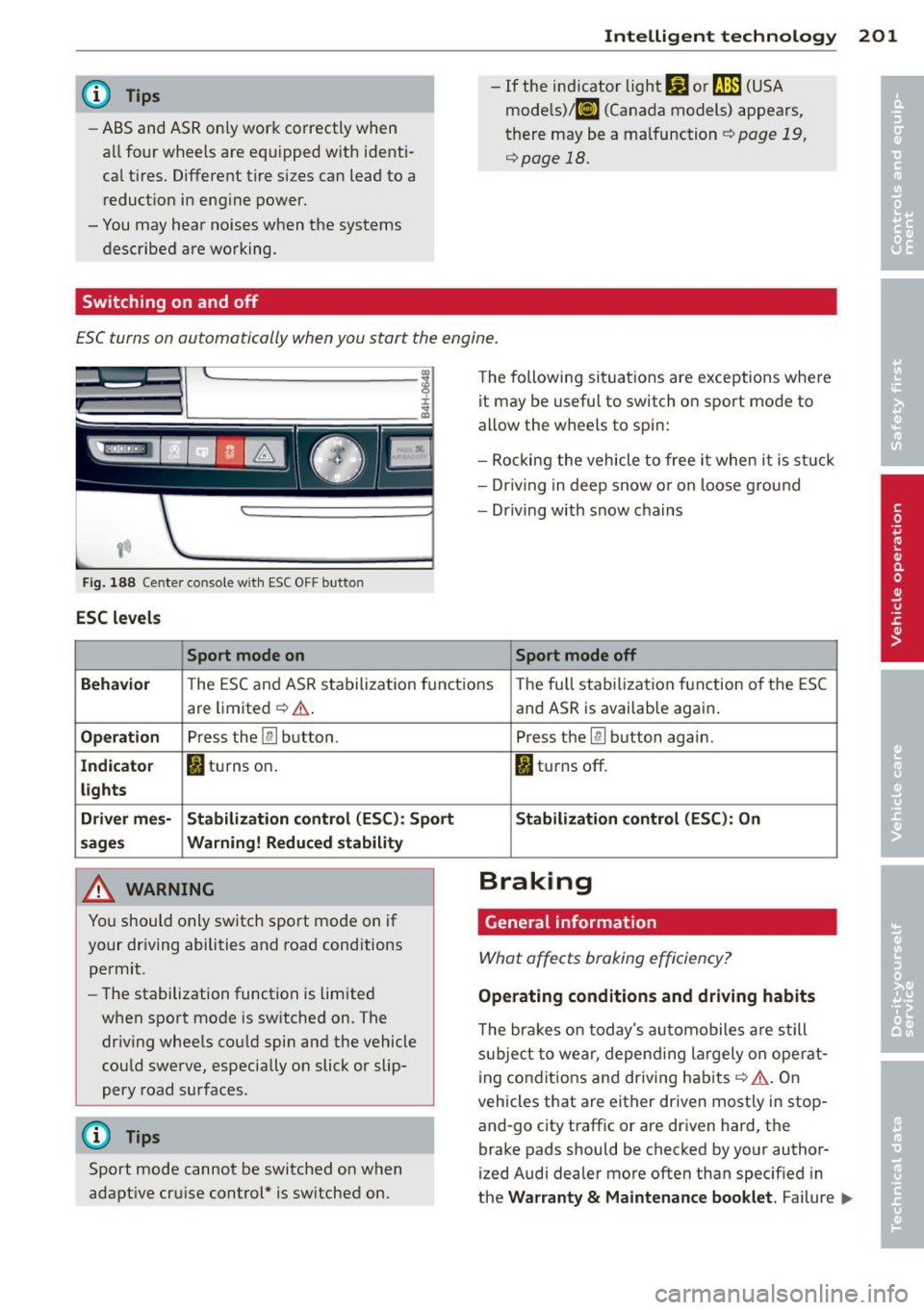
@ Tips
-ABS and AS R on ly wor k co rrectly when
a ll fo ur wheels are eq uipped w ith identi
ca l tires . Different tire s izes can lead to a
r educt io n in eng ine power.
- You may hear noises when the sys tems
desc ribed are working.
Switching on and off
Intelligent technology 201
- If the ind ica tor li ght DJ o r til1 (U SA
mo dels)/ [!] (Canada models) appea rs,
there may be a malfunc tion
r:::> page 19,
¢page 18.
ESC turns on automatically when you start the engine.
Fig . 188 Center co nsole with ESC O FF bu tton
ESC levels
Sport mode on
The following si tua tions are exceptions whe re
it may be usefu l to switch o n sport mo de to
allow the w heels to spi n:
- Rockin g the vehicle to free it when i t is st uck
- Dr iv ing in deep s now o r on loose g ro un d
- Dr iving with snow chains
Sport mode off
Behavior
T he E SC and AS R sta bilization f unct io ns The fu ll sta biliz ati on f uncti on o f the ES C
are limited¢ ,&.
Operation Press the [ru button .
Indicator II turns on .
lights
Driver mes· Stabilization control (ESC): Sport
sages Warning! Reduced stability
A WARNING
Yo u should o nly sw itch sport mo de on i f
your dr iv ing abili ties and road cond itions
permit.
- The stabilization function is limited
when sport mode is sw itched on. The
dr iv ing whee ls co uld spin and the vehicle
cou ld swe rve , especially on slick or slip
pery road surfaces.
(D Tips
Sport mode cannot be switched o n when
adapt ive cr uise c ontrol* is sw itched on.
-
and AS R is availab le again .
Press the
[ru button again .
II tur ns off.
Stabilization control (ESC): On
Braking
General information
What affects braking efficiency?
Operating conditions and driving habits
The bra ke s on today's au to m obiles a re s till
sub ject t o wear, depe nding la rgely o n ope rat
i ng con dit ions and d riving habits¢
A . On
vehicles that are either driven most ly in stop
and-go city traff ic or are driven hard , the
brake pads should be checked by your author
ized Audi dealer more often than specif ied in
t h e
Warranty & Maintenance booklet . Failure .,..
Page 204 of 314

202 Intellig ent technol ogy
to have your brake pads inspected can result
in reduced brake performance.
On steep slopes, yo u shou ld use the b rak ing
effect of the engine. Th is way, you prevent un
necessary wear on the brake system. If you
must use your brakes, do not hold the brakes
down continuously. P ump the brakes at inter
vals.
Operating nois e
Noises may occur when braking depending on
the speed, braking force and outside condi
tions such as temperature and humidity.
E ff ect of water and road salt
In certain situat ions, for example after driving
through water , in heavy ra in , after overn ight
condensation or after washing your car, the braking effect can be reduced by moisture or
ice on the brake rotors and brake pads. The
brakes must be dried first with a few careful
brake applications.
At higher speeds and with the windshield wip
ers turned on, the brake pads press against
the brake rotors for a short amount of time.
This occurs at regular intervals without the
driver noticing and provides for bet ter brake
response time under wet condit ions .
The effectiveness of the brakes can be reduced
when the vehicle is dr iven on a salt-covered
road and the brakes are not used . Likew ise,
you clean off accumulated salt coating from
brake discs and pads with a few caut ious ap
plications of the brake
9 .&, .
Cor ro sion
There may be a tendency for dirt to build up
on the brake pads and corrosion to form on
the discs if the car is not dr iven regularly or
only for short t rips with little use of the
b rakes .
If the brakes are not used frequently , or if cor
rosion has formed on the discs, it is advisable
to clean off the pads and discs by braking
firm ly a few times from a mode rately high
speed
9 .&, .
Faults in the brake syste m
If you shou ld notice a sudden increase in
brake pedal trave l, then one of the two brake
circuits may have fai led
9 & .
Low bra ke fluid lev el
Malfunctions can occu r in the bra ke system if
the b rake fluid level is too low. The brake flu id
level is monitored electro nica lly.
Brake lining we ar statu s
Brake lining wear may be checked by visual in
spect ion of the condition of the brake pads
th rough the open ings in the wheel. If neces
sary, the wheel may be removed for t his i n
spect ion
9 page 2 72, Changing a wheel.
A WARNING
- You shou ld perform braking maneuvers
for the purpose of cleaning the brake system only if road conditions permit.
Other road users must not be put at risk -
you may cause an accident!
- Before descending a steep grade, reduce
speed and sh ift transmission into a lower
gear or lower dr iving range. Do not ride
the brakes or hold the pedal down too
long or too often . This could cause the
b rakes to get hot and diminish braking
efficiency.
- Do not "ride the brakes" by rest ing your
foo t on the pedal when you do not intend
to brake. This may cause the brakes to
overheat, premature wear and increased
stopping distance.
- Unde r certain cl imatic and operat ing
conditions such as passing thro ugh wa
ter, driving in heavy rain or after washing
the vehicle, the effectiveness of the brakes can be reduced. In winter, ice can
accumu late on the brake pads, linings,
d iscs and drums. Carefully app ly brakes
for a test. Brakes will dry and ice coat ings will be cleaned off after a few care
fu l brake applicat ions.
- Driving for an extended period of t ime on
salt-covered roads without using your brakes can a lso affect bra king efficiency.
~
Page 205 of 314

Clean off accumulated salt coating from
brake discs and pads with a few careful
brake applicat ions .
-If you damage the front spoiler, or if you
install a different spoiler, be sure the air
flow to the front brakes is not obstruct ed . Otherwise the brake system could
overheat reducing the effectiveness of
the ent ire brake system.
- Failure of one brake c ircuit will impair
the braking capability resulting in an in
cr eased stopp ing distance. Avoid driv ing
the vehicle and have it towed to the near est Aud i dea ler or q ualified wor kshop .
- Never let the vehicle rol l to a stop w ith
t he engine shu t off.
- If the brake booster is not work ing, the
brake pedal must be pressed conside ra
bly harder to make up for the lac k of
booster assistance.
Brake booster
The brake booster adds extra braking power.
The brake booster works w ith vacuum pres
sure which is created only when the engine is
ru nning
9 ,&. .
,&. WARNING
-Never le t the vehicle ro ll to a stop w ith
t he engine shu t off.
- If the brake booster is not work ing, fo r
ex ample when towing your ve hicl e, or
because the b rake booste r has somehow
been damaged, the brake pedal must be
pressed considerab ly harder to make up
for the lack of booster assistance.
Servotronic - advanced
power steering system
-
The power steering systems use the power of
the running engine to allow precise steering
with little effort.
The advanced Servotronic power steering sys
tem senses the road speed and electron ically
ad ju sts powe r ass istance to provide comfor ta-
Int ellig ent technolog y 203
ble and safe steering response exactly match
ed to th e vehicle speed .
Power steer ing will not work if the engine is
off . As a result, the steering wheel will be h ard
to tu rn.
T he powe r stee ring fluid level is checked d ur
i ng t he sched uled maintena nce services.
(D Note
If there is an e lectronic malfunction, ser
votronic
will s till fu nction like a conven
tiona l powe r steering system, providing a
constant steering s upport force tha t is no
l onge r proportionate to the vehicle speed.
This is most noticeab le when t urni ng the
steering wheel at low speeds (for example
when parking), -more effort w ill be re
quired than usual.
- Be aware of the different than usual steering response and adjust your steer
ing force accordingly.
- Have the problem checked and set right by an Audi dealer as soon as possible.
(D Tips
-When the engine is running, never hold
the steering wheel turned all the way to
the right or to the left for longer than 15
seconds . The power steering pump will
overheat the hydraulic fluid if yo u keep
holding the stee ring wheel turned all the
way. This is likely to damage the power
steering sys tem.
- If the powe r stee ring system should fa il
entire ly, o r if t he engine is not runn ing
(for example, wh ile be ing towed), you
w ill still be able to steer the veh icle .
However,
considerably more effort will
be required to do so .
- If the powe r steering system sho uld
have a leak, or is not functioning proper
ly, contact your author ized Audi dealer
immediately.
- The power steering system req uires a
specially formu lated hydraulic fluid. The
power steering fluid reservoir is located
in the engine compartment
9 page 233. IJJ,,
•
•
Page 206 of 314
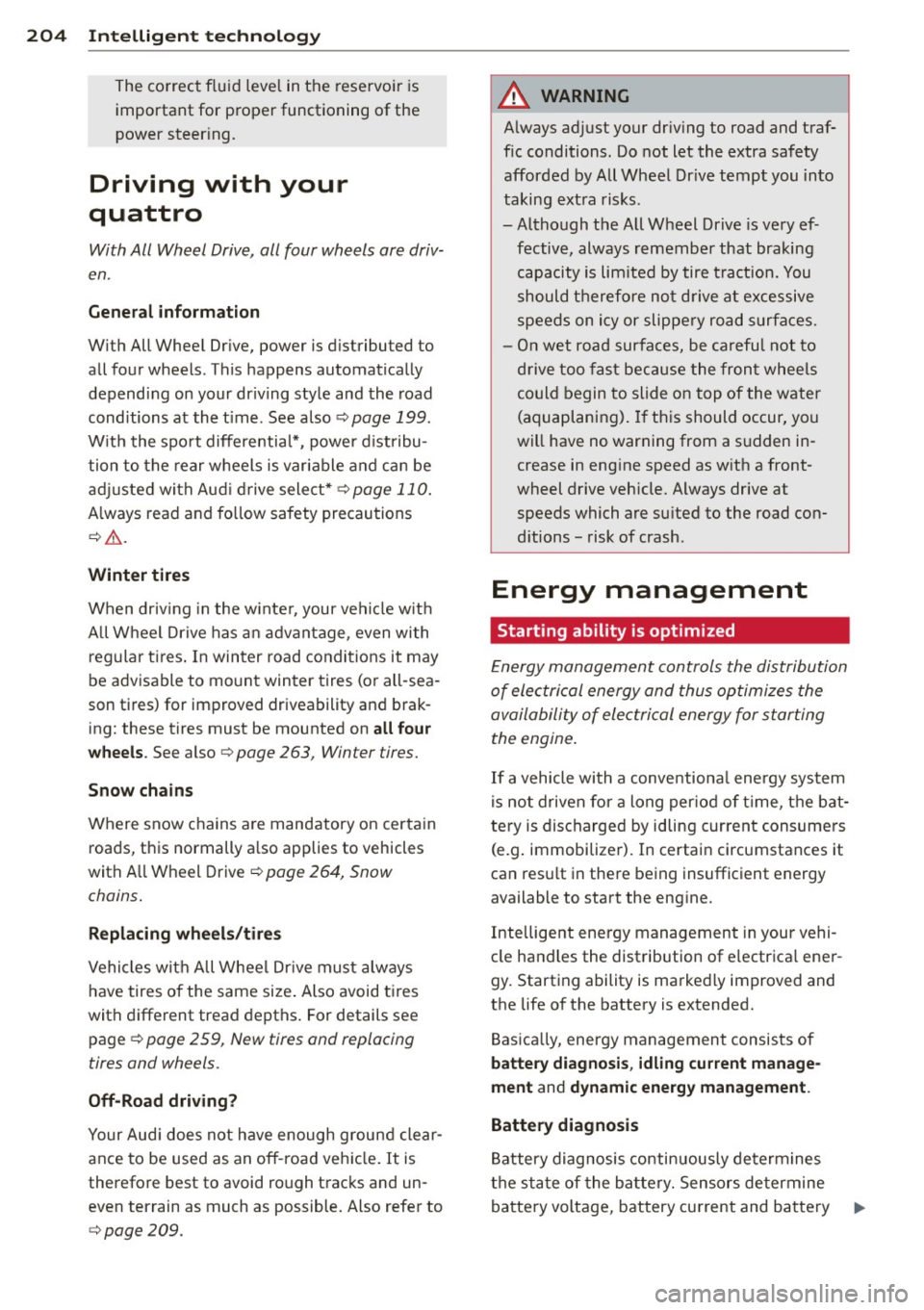
204 Intelligent technology
The correct f luid leve l in the reservoi r is
important for proper functioning of the
power steer ing.
Driving with your
quattro
With All Wheel Drive, all four wheels are driv
en.
General information
With All Wheel Drive, power is distributed to
all four wheels . This happens automatically
depending on your dr iving style and the road
conditions at the t ime . See a lso
c::;, page 199.
W ith the sport differential*, power distribu
tion to the rear wheels is var iable and can be
ad justed with Aud i drive select*
c::;,page 110.
Always read and fo llow safety precautions
¢ &, .
Winter tires
When driv ing in the w inter, your vehicle w ith
A ll Wheel Drive has an advantage, even with
r egular tires. In winter road conditions it may
be advisable to mount winter tires (or all-sea
son tires) for improved driveability and brak ing: these tires must be mounted on all four
wheels. See also c:;, page 263, Winter tires.
Snow chains
Where snow chains are mandatory on certain
roads, this normally a lso applies to vehicles
with A ll Wheel Drive
¢ page 264, Snow
chains.
Replacing wheels/tires
Vehicles with A ll Wheel Dr ive must always
have tires of the same size . Also avoid ti res
with different tread depths. For details see
page
c:;, page 2 59, New tires and replacing
tires and wheels.
Off-Road driving?
Your Aud i does not have enough ground clear
ance to be used as an off -road vehicle. It is
therefore best to avoid rough tracks and un
even terrain as much as possible. Also refer to
c::;, page209.
A WARNING
Always adjust your driving to road and traf
f ic conditions. Do not let the extra safety
afforded by All Wheel Drive tempt you into
taking extra risks.
- Although the All Wheel Drive is very ef
fective, always remember that braking
capacity is lim ited by tire traction. You
should therefore not drive at excessive
speeds on icy or slippery road surfaces.
- On wet road surfaces, be careful not to
drive too fast because the front wheels
could begin to slide on top of the water
(aquaplaning) . If this should occur, you
will have no warning from a sudden in
crease in eng ine speed as with a front
wheel drive vehicle. Always drive at speeds which are suited to the road con
ditions - risk of crash.
Energy management
Starting ability is optimized
Energy management controls the distribution
of electrical energy and thus optimizes the
availability of electrical energy for starting
the engine .
If
a vehicle with a conventiona l ene rgy system
is not driven for a long period of time, the bat
tery is discharged by idling current consumers
(e .g . immobilizer). In certain circumstances it
can resu lt in there being insufficient energy
available to start the engine .
Intelligent energy management in your vehi
cle handles the distribution of e lectrica l ener
gy. Starting ability is markedly improved and
the life of the battery is extended.
Basically, energy management consists of
battery diagnosis , idling current manage
ment
and dynamic energy management.
Battery diagnosis
Battery diagnosis continuously determines
the state of the battery. Sensors determine
battery voltage, battery current and battery ..,.
Page 207 of 314
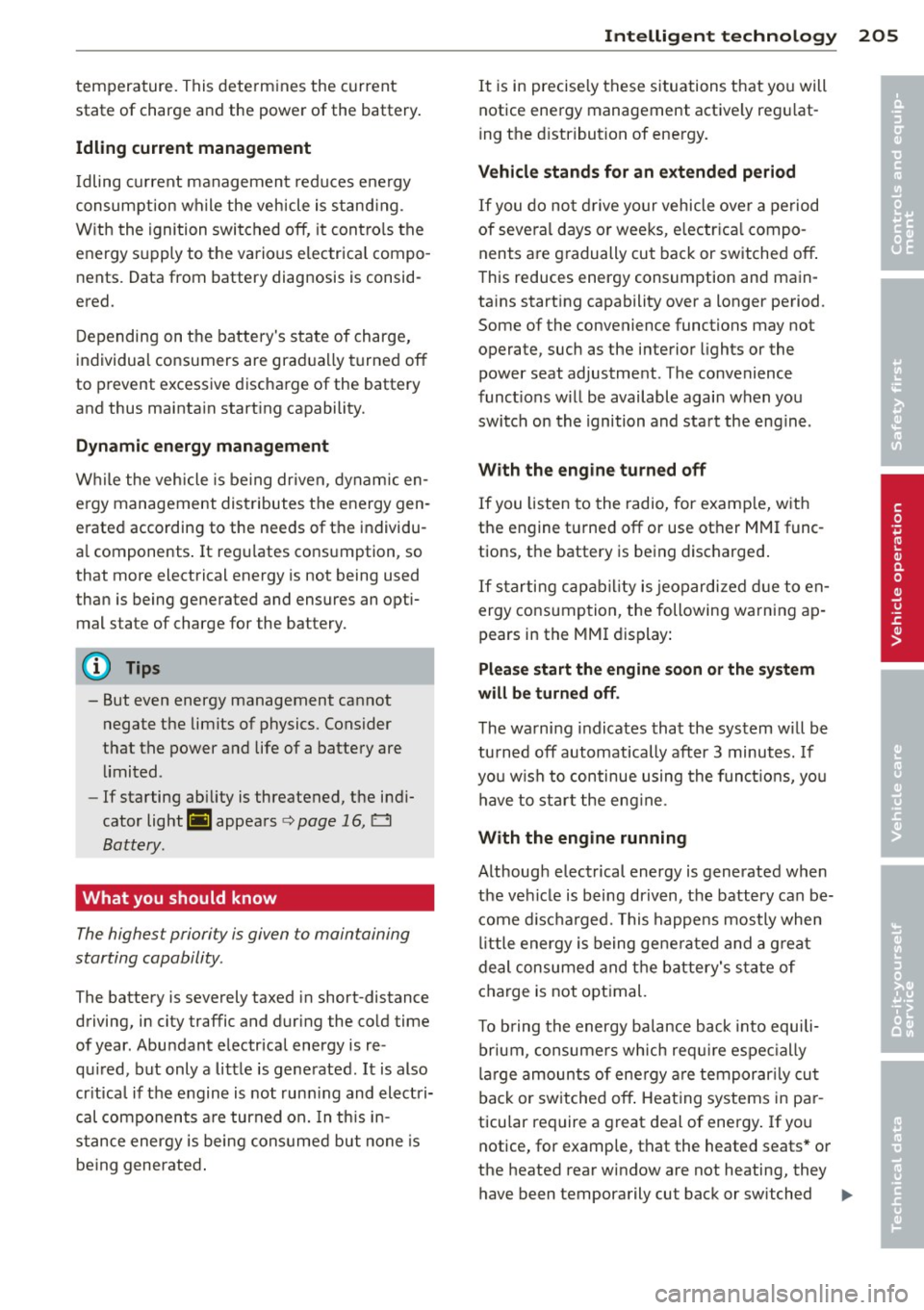
temperature. This determines the current
state of charge and the power of the battery.
Idling current management
Idling current management reduces energy
consumpt ion while the vehicle is stand ing.
With the ignition switched off, it contro ls the
energy supply to the various e lectrica l compo
nents . Data from battery diagnosis is consid
ered.
D epending on the battery's state of charge,
individua l consumers are gradua lly turned off
to prevent excessive discharge of the battery
and thus maintain starting capability.
Dynamic energy management
While the veh icle is being driven, dynamic en
ergy management dist ributes the energy gen
erated according to the needs of the individu
a l components . It regu lates consumption, so
that more electrical energy is not being used
than is being generated and ensures an opti
mal state of charge for the battery.
- But even energy management cannot negate the limits of physics. Consider
that the power and life of a battery are
limited.
- If starting ab ility is threatened, the indi
cator light(•) appears
c> page 16, D
Battery.
What you should know
The highest priority is given to maintaining
starting capability .
The battery is severely taxed in short-distance
driving, in city traffic and during the co ld time
of year. Abundant electrical energy is re
qu ired, but only a little is generated. It is also
cr itica l if the engine is not running and electri
cal components are turned on. In th is in
stance energy is being consumed but none is
be ing generated .
Intelligent technology 205
It is in precisely these situations that you will
notice energy management active ly regu lat
ing the distribution of energy.
Vehicle stands for an extended period
If you do not drive your vehicle over a period
of several days or weeks, e lectrica l compo
nents are gradually cut back or switched off.
This reduces energy consumption and main
tains starting capability over a longer period .
Some of the convenience functions may not
operate, such as the interior lights or the
power seat adjustment . The convenience
functions will be available again when you
switch on the ignition and start the eng ine.
With the engine turned off
If you listen to the radio, for example, with
the engine turned off or use other MMI func
tions, the battery is being discharged.
If starting capability is jeopardi zed due to en
ergy consumption, the following warning ap
pears in the MM I display:
Please start the engine soon or the system
will be turned off.
The warning indicates that the system will be
turned off automatically after 3 minutes. If
you w ish to continue using the functions, you
have to start the engine.
With the engine running
Although electrical energy is generated when
the vehicle is being driven, the battery can be
come discharged. This happens mostly when
li ttle energy is being generated and a great
deal consumed and the battery's state of
charge is not optimal.
T o b ring the energy ba lance back into equili
brium, consumers wh ich requ ire espe cially
large amounts of energy are temporarily cut
back or switched off . Heating systems in par
ticular require a great deal of energy. If you
notice, for examp le, that the heated seats* or
the heated rear window are not heating, they
have been temporarily cut back or switched .,.
•
•
Page 208 of 314
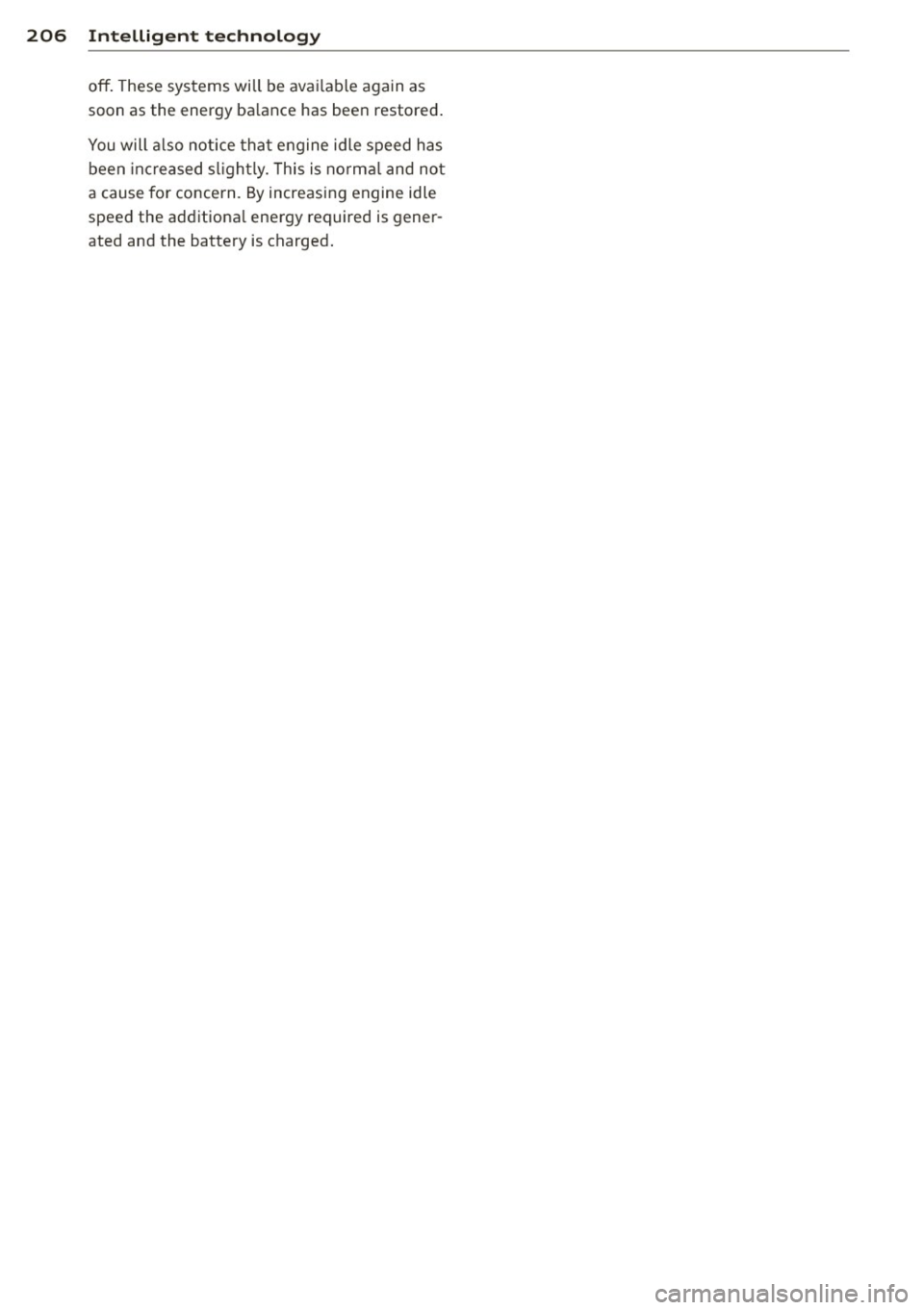
206 Intelligent technology
off. These systems will be avai lable again as
soon as the energy ba lance has been restored.
You will also notice that engine idle speed has
been increased s lightly. This is normal and not
a cause for concern. By increasing engine idle
speed the additiona l energy required is gener
ated and the battery is charged .
Page 209 of 314
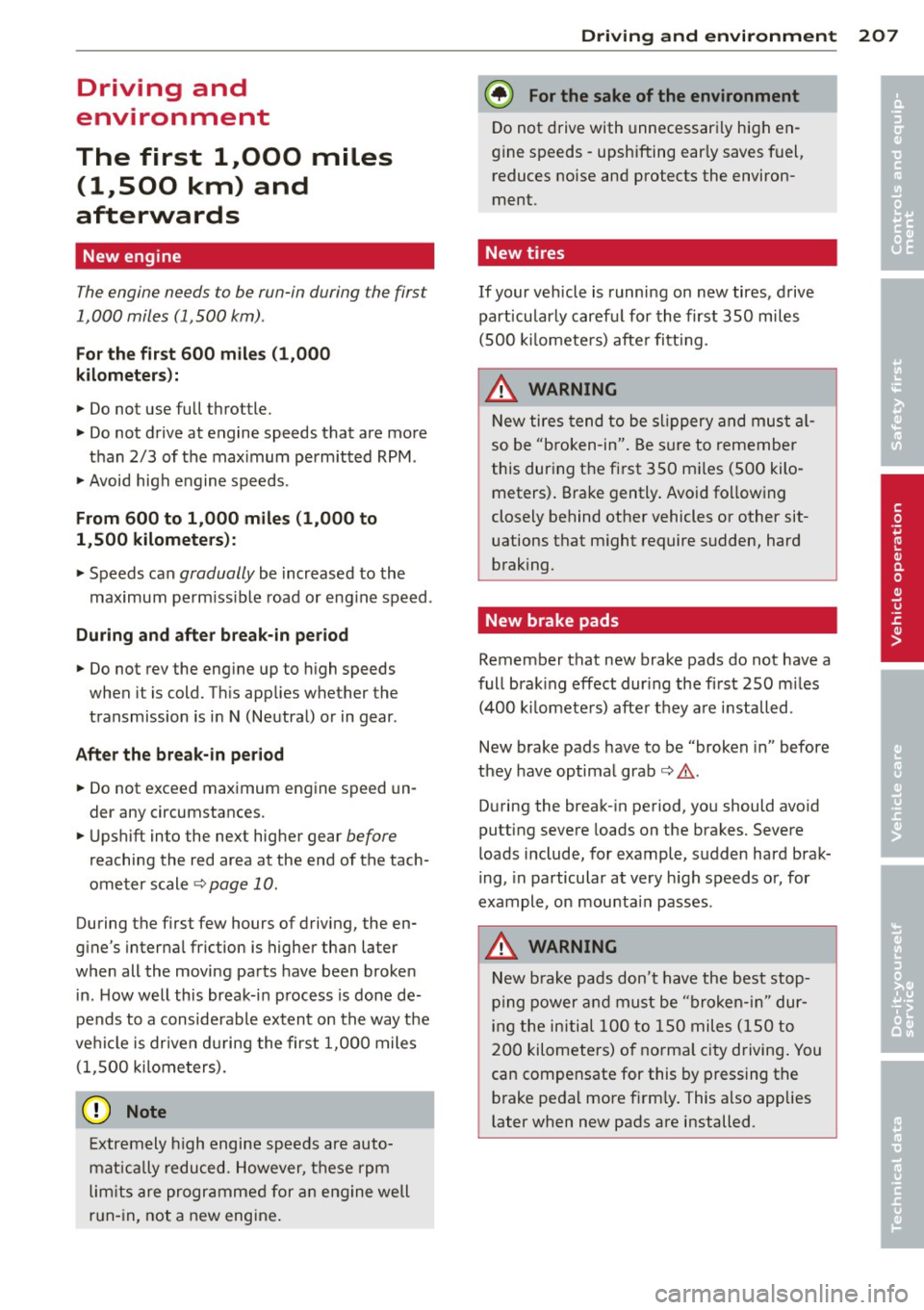
Driving and
environment
The first 1
1000
miles
(11500 km) and
afterwards
New engine
The engine needs to be run-in during the first
1,000 miles (1 ,500 km) .
For the first 600 mile s (1,000
kilometers ):
.,. Do not use full throttle.
.,. Do not drive at engine speeds that are more
than 2/3 of the max imum permitted RPM .
.. Avoid high engine speeds .
From 600 to 1,000 mile s (1 ,000 to
1,500 kilometers):
.. Speeds can gradually be increased to the
maximum pe rm iss ib le road or eng ine speed .
During and after break-in per iod
.,. Do not rev the engine up to high speeds
when it is cold. This applies whether the
transmission is i n N (Neutra l) or in gear.
After the break- in peri od
.. Do not exceed maximum engine speed un
der any circumstances.
.,. Upshift into the next higher gear
before
reaching the red area at the end of the tach
ometer scale
¢page 10.
During the first few hours of driving, the en
g ine's interna l friction is higher than later
when all the moving parts have been broken
i n. How well this break-in p rocess is done de
pends to a considerable extent on the way the
ve hicl e is driven du ring the first 1,000 miles
(1,500 ki lome ters).
(D Note
Extremely h igh engine speeds are auto
mat ica lly reduced. However, t hese rpm
lim its are progr amme d for an eng ine well
r u n- in, not a new engine .
Driving and environment 207
@) For the sake of the environment
Do not drive with unnecessarily high en
g ine speeds -upshifting ear ly saves f uel,
reduces noise and protects the environ
ment.
New tires
If your vehicle is running on new tires, drive
particularly caref ul for the first 350 miles
(500 kilomete rs) afte r fitt ing.
.&, WARNING
N ew tires tend to be sl ippery and mus t al
so be "b roken -in" . Be sure to remember
this dur ing the f irst 350 m iles (500 kilo
meters) . Brake gently . Avoid fo llowing
closely behind other vehicles or other sit
uations that m ight require sudden, hard
b raking .
New brake pads
Remember that new brake pads do not have a
full brak ing effect dur ing the first 250 m iles
(400 ki lomete rs) afte r they are installed.
New brake pads have to be "broken in" before
they have optima l grab ¢,&. .
D uring the brea k-in period, yo u should avo id
putting severe loads on the brakes. Severe
l oads include , for example, sudden hard brak
i ng, in particular at very h igh speeds or, for
example, on mounta in passes .
.&, WARNING
New b rake pads don't have the best stop
p ing power and must be "broken-i n" dur
ing the initi al 100 to 150 miles (150 to
2 00 kilometers) o f no rma l ci ty driving . You
can compensate for this by pressing the b rake peda l more fi rm ly . This also applies
later when new pads are installed.
•
•
Page 210 of 314
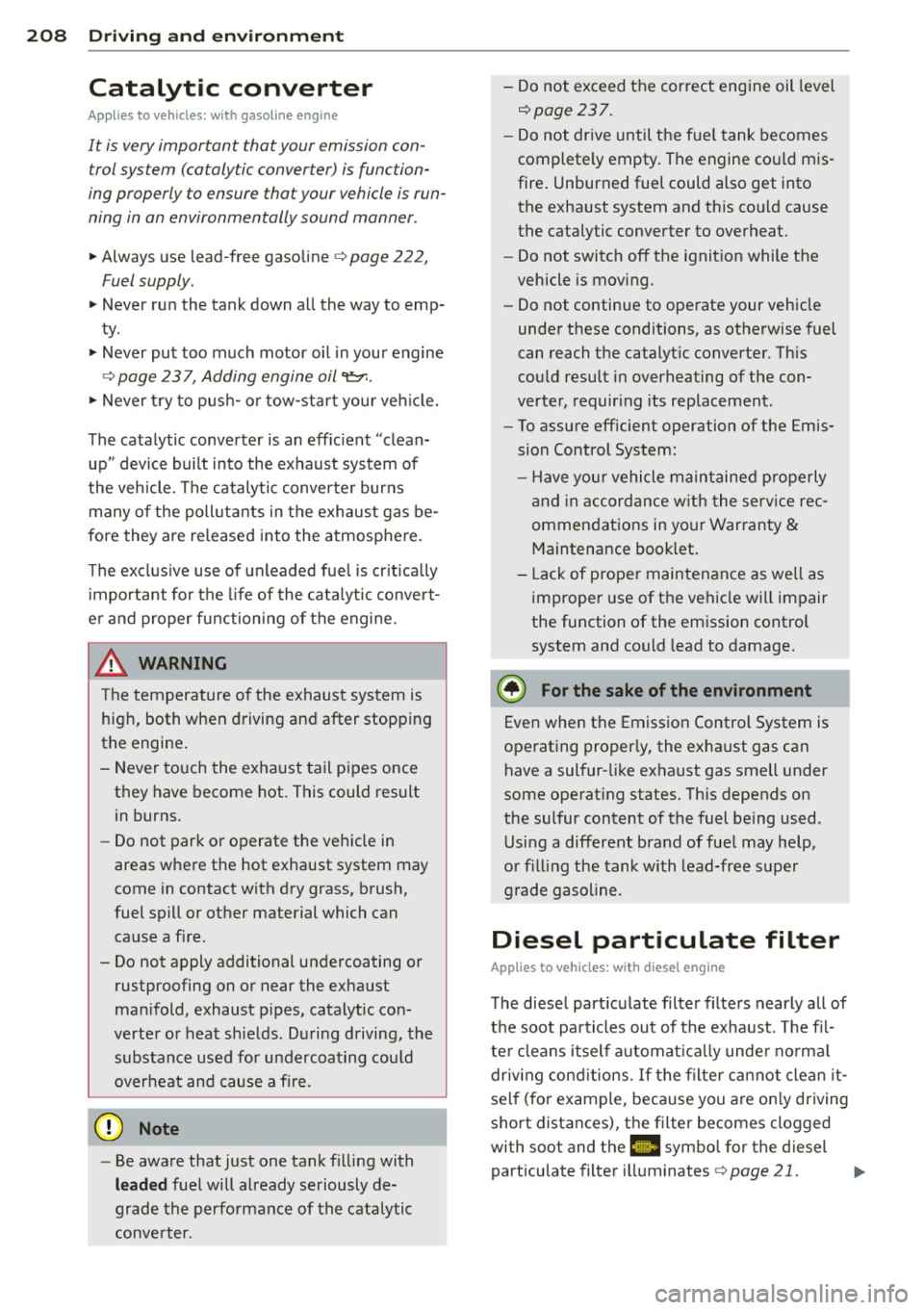
208 Driving and en vir onm ent
Catalytic converter
Appl ies to vehicles: with gasoline e ngin e
It is very important that your emission con
trol system (catalytic converter) is function
ing properly to ensure that your vehicle is run
ning in an environmentally sound manner .
.. Always use lead-free gasoline i=> page 222,
Fuel supply .
.. Never run the tank down all the way to emp-
ty .
.. Never put too much motor oil in your engine
¢ page 23 7, Adding engine oil
The catalytic converter is an eff ic ient "clean
up" device built into the exhaust system of
the vehicle. The catalyti c converter burns
many of the pollutants in the exhaust gas be
fore they are released into the atmosphere.
The exclus ive use of unleaded fuel is cr itically
important for the l ife of the cata lytic convert
e r and proper functioning of the engine.
A WARNING
T he temperature of the exhaust system is
high, both when driving and after stopping
the engine .
- Never touch the exhaust tail pipes once
they have become hot. This could result
in burns.
- Do not park or operate the vehicle in
areas where the hot exhaust system may
come in contact with dry grass, brush,
fuel spill or other material which can
cause a fire.
- Do not apply additional undercoating or
rustproofing on or near the exhaust
man ifold, exhaust p ipes, catalytic con
verter or heat shields . During driving, the
substance used for undercoating cou ld
overheat and cause a fire.
@) Note
- Be aware that just one tank f illing with
leaded fuel will already seriously de
grade the performance of the cata lytic
conve rter. -
Do not exceed the correct engine oil level
i=>page 237.
-Do not drive until the fue l tank becomes
completely empty . The engine co uld mis
fire . Unburned fuel could also get into
the exhaust system and this cou ld cause
the catalytic converter to overheat.
- Do not switch off the ignition while the
vehicle is mov ing.
- Do not continue to operate your vehicle
under these conditions, as otherwise fuel
can reach the catalyt ic converter. Th is
cou ld result in overheating of the con
verter, requir ing its replacement .
- To assure efficient operation of the Emis
sion Control System:
- Have you r vehicle maintained p roperly
and in accordance w ith the service rec
ommendations in your Warranty & Maintenance book let.
- Lack of prope r maintenance as we ll as
improper use of the vehicle wi ll impair
the function of the em ission contro l
system and could lead to damage.
@) For the sa ke of the en vironment
Even when the Emission Control System is
ope rat ing properly, the exhaust gas can
have a sulfur-like exhaust gas smell under
some operat ing states. This depends on
the sulfur content of the fuel being used .
Using a different brand of fuel may help,
or f illing the tank with lead-free super
grade gasoline.
Diesel particulate filter
Applies to vehicles: with diese l eng ine
The diesel part icu late filter filters nearly all of
the soot pa rticles out of the exhaust . T he fil
ter cleans itself automat ica lly unde r no rma l
dr iv ing cond itions . If the filte r cannot clean it
self (for example, because you are on ly driving
short distances), the filter becomes clogged
with soot and the
II symbol for the diesel
particulate filter i lluminates
i=> page 21. ..,.
Page 211 of 314
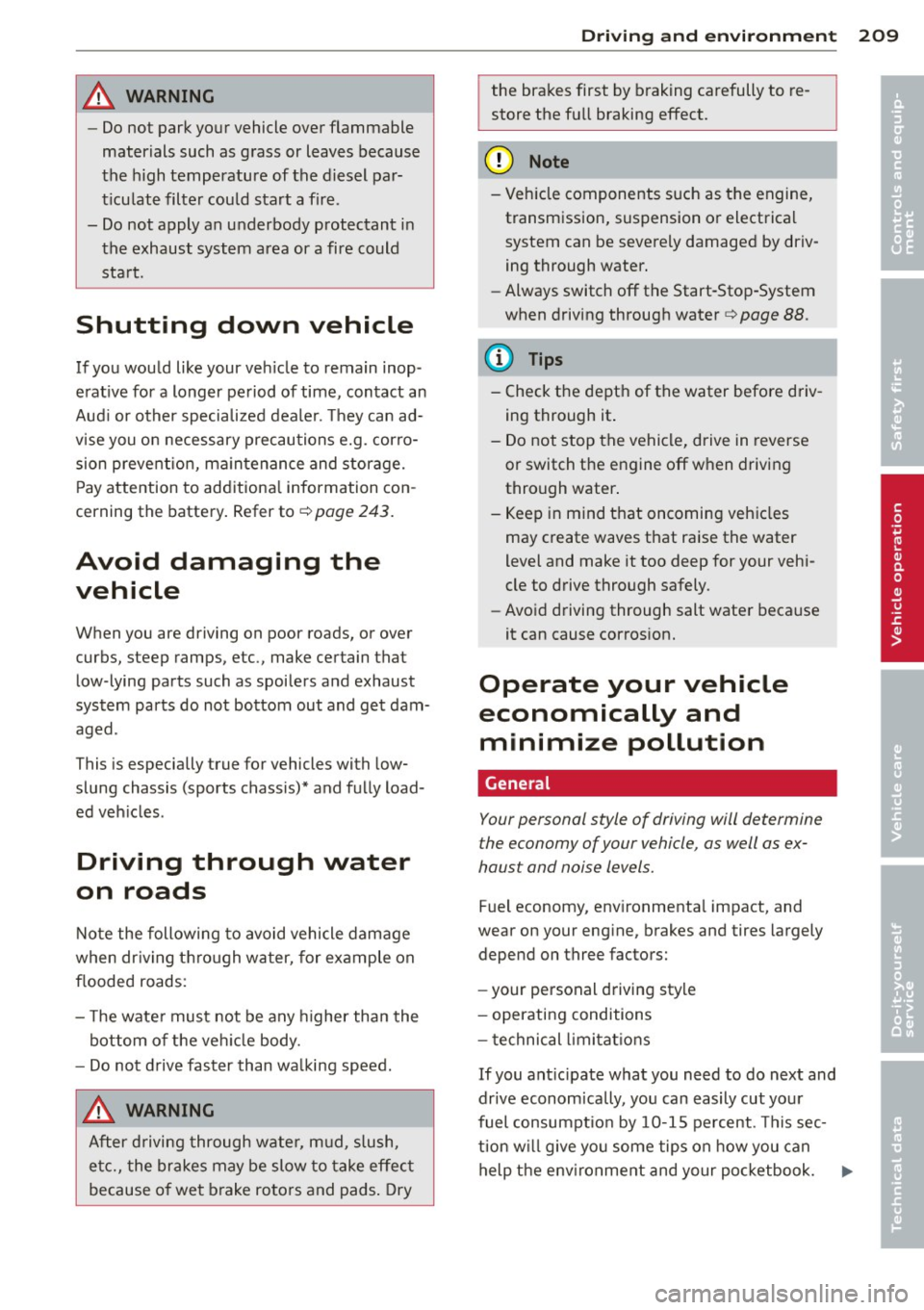
A WARNING ,~
- Do not park your vehicle over flammable
materials such as grass or leaves because
the high temperature of the diesel par
t icu late filter cou ld start a fire .
- Do not apply an underbody protectant in the exhaust system area or a fire could start .
Shutting down vehicle
If you would like your veh icle to remain inop
erat ive for a longer period of time, contact an
Aud i or other specia lized dealer. They can ad
vise you on necessary precautions e.g . corro
sion prevention, ma intenance and storage.
Pay attention to additiona l information con
cerning the battery. Refer to~
page 243.
Avoid damaging the
vehicle
When you a re driving on poor roads, or over
curbs, steep ramps, etc., make certain that low-lying parts such as spoilers and exhaust
system parts do not bottom out and get dam
aged.
This is especially true for vehicles with low
slung chassis (sports chassis)* and fully load
ed vehicles.
Driving through water
on roads
Note the following to avoid vehicle damage
when driving through water, for example on
flooded roads :
- The water must not be any higher than the
bottom of the veh icle body.
- Do not drive faster than wa lking speed.
A WARNING
After driving through water, mud, slush,
etc., the brakes may be slow to take effect
because of wet brake rotors and pads. Dry
-
Drivin g and environment 209
the brakes first by braking carefully to re
store the full braking effect.
(D Note
- Vehicle components such as the engine,
transmission, suspension or electrical
system can be severely damaged by driv
ing through water.
- Always switch off the Start-Stop-System
when driving through water~
page 88.
(D Tips
-Check the depth of the water before driv
ing through it .
- Do not stop the vehicle, drive in reverse
or switch the engine off when driving
through water.
- Keep in mind that oncoming vehicles may create waves that raise the water
level and make it too deep for your vehi
cle to drive through safely .
- Avoid driving through salt water because
it can cause corrosion.
Operate your vehicle
economically and minimize pollution
General
Your personal style of driving will determine
t he economy of your vehicle , as well as ex
haus t and noise levels.
Fuel economy, environmental impact, and
wear on your engine, brakes and tires largely
depend on three factors:
- your personal driving style
- operating conditions
- technical limitations
If you ant icipate what you need to do next and
drive econom ically, you can easily cut your
fuel consumpt ion by 10-15 percent . Th is sec
tion w ill give you some tips on how you can
help the env ironment and your pocketbook. •
•